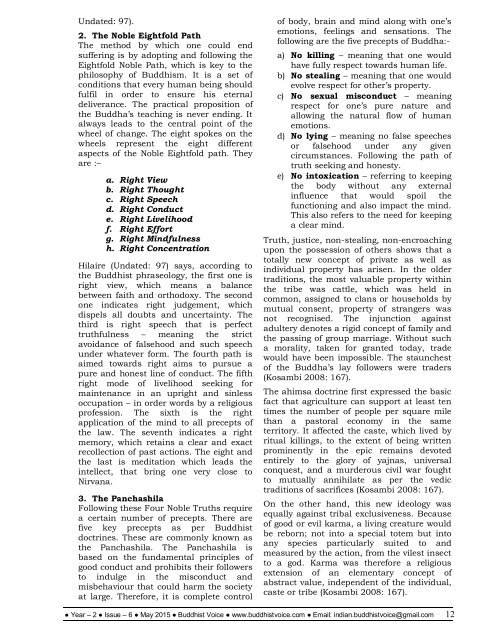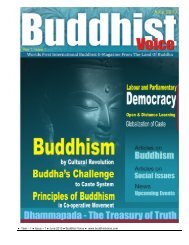BV - May 2015 Yr 2 Issue 6 E
You also want an ePaper? Increase the reach of your titles
YUMPU automatically turns print PDFs into web optimized ePapers that Google loves.
Undated: 97).<br />
2. The Noble Eightfold Path<br />
The method by which one could end<br />
suffering is by adopting and following the<br />
Eightfold Noble Path, which is key to the<br />
philosophy of Buddhism. It is a set of<br />
conditions that every human being should<br />
fulfil in order to ensure his eternal<br />
deliverance. The practical proposition of<br />
the Buddha’s teaching is never ending. It<br />
always leads to the central point of the<br />
wheel of change. The eight spokes on the<br />
wheels represent the eight different<br />
aspects of the Noble Eightfold path. They<br />
are :–<br />
a. Right View<br />
b. Right Thought<br />
c. Right Speech<br />
d. Right Conduct<br />
e. Right Livelihood<br />
f. Right Effort<br />
g. Right Mindfulness<br />
h. Right Concentration<br />
Hilaire (Undated: 97) says, according to<br />
the Buddhist phraseology, the first one is<br />
right view, which means a balance<br />
between faith and orthodoxy. The second<br />
one indicates right judgement, which<br />
dispels all doubts and uncertainty. The<br />
third is right speech that is perfect<br />
truthfulness – meaning the strict<br />
avoidance of falsehood and such speech<br />
under whatever form. The fourth path is<br />
aimed towards right aims to pursue a<br />
pure and honest line of conduct. The fifth<br />
right mode of livelihood seeking for<br />
maintenance in an upright and sinless<br />
occupation – in order words by a religious<br />
profession. The sixth is the right<br />
application of the mind to all precepts of<br />
the law. The seventh indicates a right<br />
memory, which retains a clear and exact<br />
recollection of past actions. The eight and<br />
the last is meditation which leads the<br />
intellect, that bring one very close to<br />
Nirvana.<br />
3. The Panchashila<br />
Following these Four Noble Truths require<br />
a certain number of precepts. There are<br />
five key precepts as per Buddhist<br />
doctrines. These are commonly known as<br />
the Panchashila. The Panchashila is<br />
based on the fundamental principles of<br />
good conduct and prohibits their followers<br />
to indulge in the misconduct and<br />
misbehaviour that could harm the society<br />
at large. Therefore, it is complete control<br />
of body, brain and mind along with one’s<br />
emotions, feelings and sensations. The<br />
following are the five precepts of Buddha:-<br />
a) No killing – meaning that one would<br />
have fully respect towards human life.<br />
b) No stealing – meaning that one would<br />
evolve respect for other’s property.<br />
c) No sexual misconduct – meaning<br />
respect for one’s pure nature and<br />
allowing the natural flow of human<br />
emotions.<br />
d) No lying – meaning no false speeches<br />
or falsehood under any given<br />
circumstances. Following the path of<br />
truth seeking and honesty.<br />
e) No intoxication – referring to keeping<br />
the body without any external<br />
influence that would spoil the<br />
functioning and also impact the mind.<br />
This also refers to the need for keeping<br />
a clear mind.<br />
Truth, justice, non-stealing, non-encroaching<br />
upon the possession of others shows that a<br />
totally new concept of private as well as<br />
individual property has arisen. In the older<br />
traditions, the most valuable property within<br />
the tribe was cattle, which was held in<br />
common, assigned to clans or households by<br />
mutual consent, property of strangers was<br />
not recognised. The injunction against<br />
adultery denotes a rigid concept of family and<br />
the passing of group marriage. Without such<br />
a morality, taken for granted today, trade<br />
would have been impossible. The staunchest<br />
of the Buddha’s lay followers were traders<br />
(Kosambi 2008: 167).<br />
The ahimsa doctrine first expressed the basic<br />
fact that agriculture can support at least ten<br />
times the number of people per square mile<br />
than a pastoral economy in the same<br />
territory. It affected the caste, which lived by<br />
ritual killings, to the extent of being written<br />
prominently in the epic remains devoted<br />
entirely to the glory of yajnas, universal<br />
conquest, and a murderous civil war fought<br />
to mutually annihilate as per the vedic<br />
traditions of sacrifices (Kosambi 2008: 167).<br />
On the other hand, this new ideology was<br />
equally against tribal exclusiveness. Because<br />
of good or evil karma, a living creature would<br />
be reborn; not into a special totem but into<br />
any species particularly suited to and<br />
measured by the action, from the vilest insect<br />
to a god. Karma was therefore a religious<br />
extension of an elementary concept of<br />
abstract value, independent of the individual,<br />
caste or tribe (Kosambi 2008: 167).<br />
● Year – 2 ● <strong>Issue</strong> – 6 ● <strong>May</strong> <strong>2015</strong> ● Buddhist Voice ● www.buddhistvoice.com ● Email: indian.buddhistvoice@gmail.com 12



